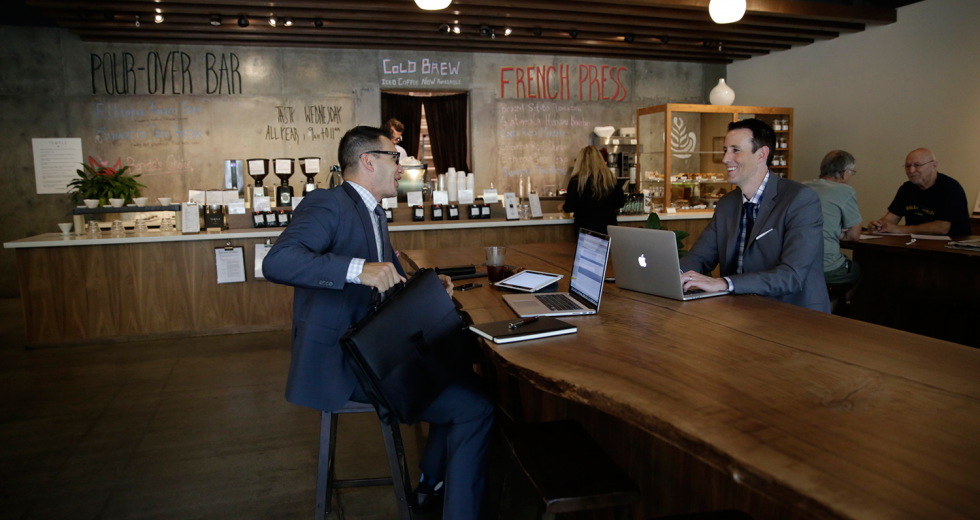Alex Medina and Brandon McKelvey’s new law firm looks more like a bootstrapped tech startup than a high-end legal practice. Their payroll consists of the pair plus an administrative assistant. They can “plug and play” with contract lawyers who, like them, are refugees from big firms who built solid books of business and left for better quality of life, Medina says. They contract their bookkeeping and marketing and work from coffee shops or home when not meeting clients.
It’s one model among the boutique firms whose numbers have taken off in the region this year. The improving economy, a buyer’s market for legal services, and the lures of startup culture have upended Sacramento’s legal landscape.
McKelvey and Medina are using product differentiation to sell themselves, a strategy unusual in law. “There’s a perception that if you need top-notch attorneys, you need to hire a big law firm. We’re here to change that perception,” notes their website in bold letters. They know their competition well; McKelvey was, until April, a Sacramento-based partner at the 800-attorney international firm Seyfarth Shaw. Medina left the Sacramento office of DLA Piper, which has about 4,200 lawyers globally, in January 2013.
The whole launch cost them $10,000. And that lets them offer lower prices — in some cases, 30 to 40 percent less than what clients are paying at large firms, McKelvey claims.
The (Legal) World Is Flat
This year, at least seven boutique firms launched in the Capital Region, initiatives of dozens of attorneys who cast off from their motherships between January and July. Downey Brand, the area’s largest firm, lost 16 lawyers in that period alone. Many of them left for startups.
“I haven’t seen anything like this in the 24 years that I’ve been practicing in Sacramento,” says Jeff Koewler, a former managing partner at Downey who left in April with four others to start Delfino Madden O’Malley Coyle & Koewler. The same is happening in other legal markets around the country, too, says Craig Brown, a consultant with LawVision Group who has worked with a number of Sacramento practices.
The economy’s steady upturn has helped ignite the startup boom. Once there’s confidence in a recovery, lawyers at bigger firms with established clients start venturing out, according to Brown. “I’ve been representing startups for over 25 years but have been practicing in large law firms for 25 years, too,” Koewler says. “Ultimately, I thought if I’m ever going to make a jump and start my own firm and be somewhat of an entrepreneur in my practice, now was the time.”
It’s also a buyer’s market in law, and that has rattled business as usual. Legal clients have more options than ever, including bringing work in-house and buying cheap services from legal process outsourcers for low-level tasks like document preparation, says Mark Medice of Thomson Reuters Peer Monitor, which assesses law firm performance. More corporations are hiring junior attorneys in house to handle tasks like contracting and compliance issues, according to legal news outlet Law 360. And fast-growing legal process outsourcers are letting companies offshore document review, fact-finding research and other less complex work.
Overall, legal industry revenues have been almost flat since 2009, according to a report in May from business research firm IBISWorld. Though legal fees are still rising about 3 percent a year, that’s down from 6 to 8 percent before 2008.
That all means the market rewards efficiency like never before. In a survey of 88 companies by legal consulting firm AdvanceLaw last fall, three-quarters said they’d move their business from a top firm to a less well-known practice if they could receive a 30-percent difference in price.
Traveling Light
That’s good news for boutiques with low overhead. Their staffing requirements, for example, run lighter than at bigger firms. Kennaday, Leavitt & Daponde launched in January with partners who left Wilke, Fleury, Hoffelt, Gould & Birney. They have one legal secretary for every four attorneys, compared with the one-to-two ratio at bigger firms, says partner Kelli Kennaday. Boutiques also tend toward smaller, more affordable office space, as in Medina McKelvey’s case. Attorneys at that firm selected a business-park office on Reserve Drive behind The Fountains in Roseville.
Boutiques also say they can more easily offer alternative billing arrangements, which clients are increasingly expecting, according to a report late last year by Maryland-based legal headhunter Major, Lindsey & Africa. Kennaday says she likes having the flexibility to offer clients billing choices that suit their needs, like a contingency fee, without having to get approval up the corporate ladder.
And as the market for legal services has fractured, more clients have begun divvying up work between firms with specific areas of expertise, says Donna Gary of Legal Administrative Services, who consults with startup law firms. Clients stick with the lawyers they have relationships with, not the firms they work for, she adds. Thomas Stewart of Stewart Ward & Josephson, which launched in Sacramento earlier this year with partners who left Downey, says all of his clients followed him to the new firm.
The Draw of Startup Culture
Boutiques also hold the same attractions that entice entrepreneurs in other industries. For starters, there’s often more money. Market changes mean there’s actually been more revenue instability at bigger firms, which has held down compensation for non-equity partners, says Brown. The numbers work for the “seasoned lawyers” who left for boutiques this year, Gary says. “When you pencil everything out, it just makes sense.”
Mitchell Chadwick, for example, launched in Roseville in January with a team of six attorneys who left Downey Brand. Partner Braiden Chadwick says that typically at larger firms, a third of each billable hour goes to salaries, a third to overhead and a third to corporate profit. But the share that goes to profit at Mitchell Chadwick is running in the 40- to 45-percent range, he says. And that’s all while paying their salaried attorneys at least what they were making in their previous positions and charging lower billing rates than at Downey, he claims.
Lifestyle and work culture also make a difference. At Mitchell Chadwick, staff have to work at the Roseville office only Tuesdays and Wednesdays, logging in from wherever they’d like otherwise. Gary says that’s typical of what she’s seen at startups; they like setting up the office the way they want, having a more personalized feel, giving small bonuses to staff, dressing down.
That more relaxed atmosphere also can draw lawyers away from bigger practices because larger firms often have leadership problems, says Wayne Russell of Chase Legal Professionals, a Sacramento recruitment firm. “Law is one of the least-best industries in terms of developing a people culture,” he says. A partner at one firm, for example, recently asked him whether he needs to thank his staff for good work — after all, he’s paying them to do that. “Why not?” Russell replied. “Does it really hurt to show appreciation? Most people want to know they’re valued.”
And Gary thinks big practices won’t be able to keep good lawyers unless they change their compensation schemes. “For the larger firms to stay successful and keep their top lawyers, they must restructure how [their lawyers] are getting paid,” she says. She thinks we haven’t seen the end of the exodus.
Don’t Count Out Big Firms Yet
But no one’s betting the small players will squeeze out bigger rivals anytime soon. Russell says that while there’s a “romance” to starting a boutique, reality also can set in for the partners who launch them. The pressure to constantly market their services, for example, doesn’t suit everyone. Five to seven years out, he often starts hearing back from boutique partners who’d like to rejoin a bigger practice. He recently consulted with two partners who started a boutique in the late ’90s; they have fewer staff than five years ago, are making less money and are looking for opportunities elsewhere.
Bigger firms argue that their advantages will still attract clients. Despite losing about a third of their lawyers since mid-last year, 2013 was Downey’s best showing ever. Profits were up 10 to 12 percent over 2012, says managing partner Scott Shapiro. He says the company has modified its compensation program at least four times since 2001 to attract top talent and is strengthening its cross-marketing of clients across Downey’s practice areas. Company chair Stan Van Vleck says the firm’s strong lineup of attorneys in a slew of specialties is the reason he and his partners merged their boutique food and agriculture practice with Downey in 2012. Doing so gave his clients access to a wider range of legal resources.
Shapiro says that while boutique firms’ ability to plug in contract attorneys as needed may sound attractive, it can leave a client doing a lot of coordination. He compares it to paying a general contractor to remodel your home versus hiring and managing the subs yourself. Overhead at large firms pays for specialized staff to handle complex closings, equipment to bind materials onsite and space to run multiple negotiations.
In litigation, there’s an advantage to having deep pockets, Van Vleck argues. A smaller firm can be “run into the ground” by a bigger opponent if they know the smaller player is working on contingency. The longer the case drags, the more likely the small firm is to cave. That will never happen at Downey, he says. Even Chadwick admits that bigger cases requiring a huge team of lawyers, such as a big securities litigation, outstrip boutiques’ capacities.
Despite the battle for clients, firms acknowledge they need each other too. Mitchell Chadwick has referred three cases to Downey already. Medina and McKelvey say they have tremendous regard for big firms.
Happily for the region’s legal clients, whoever gains from the free-for-all, disruptions like the one that has sparked competition this year can bring only good things, like better services at lower prices.
Sick of missing out? Sign up for our weekly newsletter highlighting our most popular content. Or take it a step further and become a print subscriber — it’s both glossy and affordable!
Recommended For You

Always on Time
Billable hours are under scrutiny, but they're here to stay
The billable hour is under attack. After a scandal involving allegations of overcharging at global law firm DLA Piper last spring, Northwestern University law professor Steven Harper wrote a New York Times op-ed in which he asserted that the billable-hour system serves no one.

Prospective Hires
This year law grads are more likely to land jobs
Ryan M. Norman is the son of a pharmacist, raised in Vacaville with dreams of being an FBI special agent. When that path proved unlikely, he became an attorney instead.

So Sue Me (But Please Don’t)
Our law librarian offers resources for ADA compliance
I own a small women’s apparel boutique. The neighboring sandwich shop just was served with a federal lawsuit regarding ADA compliance. I am concerned I could be next. This building is very old. Is anything “grandfathered in”? What can I do to protect myself?




